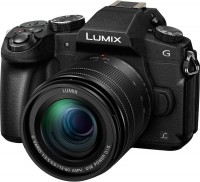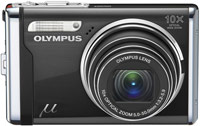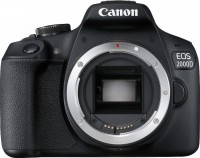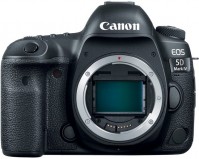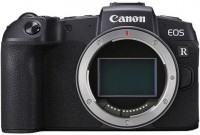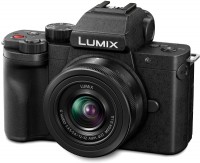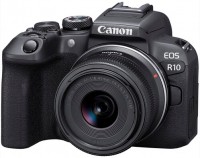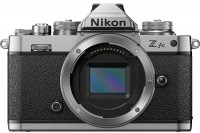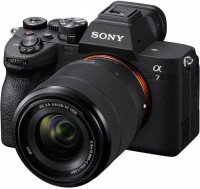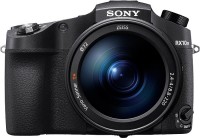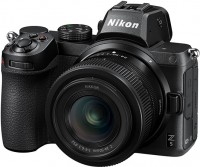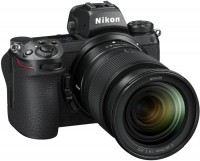Digital Cameras Fujifilm
All Digital Cameras Advanced filters → |
You might be interested in
Articles, reviews, useful tips
All materials
The best monitors for photo, video and graphics work
Five 32-inch monitors with the most accurate color reproduction for design and graphics

The Best UHS-II SD Cards for Advanced Photographers and Videographers
Fastest SD cards for reportage photography, 4K and 8K video

How does autofocus work?
When it comes to focusing on sharpness when taking photos and videos, automation can be fully relied on

Camera or camera phone: how to determine what is best for you
When is it better to buy an advanced camera phone, and when is it better to buy a camera?

5 top mirrorless cameras
The best full-frame mirrorless cameras for professional photographers and videographers

What is the aperture of optics and what does it affect?
Aperture, aperture, maximum relative aperture - in simple words about the main thing
Digital Cameras: specifications, types
Show all
Camera type
— Digital compact. This term refers to the simplest variety of modern digital cameras — those that are often called "soap dishes" in everyday life. As the name implies, these models are small in size, so most of them can be carried even in your pocket. Other specific features include a small sensor (see "Sensor Size"), a fixed lens, and a high degree of automation — digital compacts with full manual shooting options are the exception rather than the rule. In gener...al, this type of camera is designed mainly for amateur shooting — in most cases, the image quality is quite sufficient for domestic purposes, but such devices are usually unsuitable for professional photography.
— “Mirrorless” cameras MILC (Mirrorless Interchangeable Lens Camera — literally “mirrorless cameras with interchangeable lenses”) are compact cameras that are a kind of hybrid between compact digital cameras and “DSLRs”. They are not equipped with a system of mirrors, the viewfinder (if any) is made electronic or optical (see below), which allows you to minimize the weight and dimensions of the camera. On the other hand, such devices use matrices of the same class as in SLR cameras, which ensures high quality shooting with a minimum of noise. As the name suggests, MILC cameras also typically work with interchangeable lenses.
— Digital SLR cameras. The most technically advanced class of digital cameras. It got its name from the system of mirrors installed in the camera body; thanks to these mirrors, light enters the viewfinder directly through the lens (and not through the auxiliary window, as on compact cameras). As a result, the photographer sees what will be shot in real time, with high-quality colour reproduction and high brightness. It is also important that the "SLR" matrix is closed from light most of the time — the light hits it only at the time of shooting, due to which it practically does not heat up and the noise in the resulting image is minimized. The lenses of such cameras are made interchangeable, and many settings, unlike conventional digital cameras, can be set manually.
— For a mobile phone. Cameras designed to be installed on a smartphone as an external accessory and not designed for stand-alone use. Outwardly, such a device resembles a lens with a mount on the phone case; however, inside this “lens” there is a full-fledged matrix, an image processor and a Wi-Fi or Bluetooth wireless module for connecting to a smartphone. The smartphone itself, when used, simultaneously plays the role of a screen and a control device, in addition, footage can be immediately transferred to it. Technically, a similar camera can be connected to another gadget — for example, a tablet: it's not a fact that it can be fixed on the case, but the connection itself is quite possible.
— “Mirrorless” cameras MILC (Mirrorless Interchangeable Lens Camera — literally “mirrorless cameras with interchangeable lenses”) are compact cameras that are a kind of hybrid between compact digital cameras and “DSLRs”. They are not equipped with a system of mirrors, the viewfinder (if any) is made electronic or optical (see below), which allows you to minimize the weight and dimensions of the camera. On the other hand, such devices use matrices of the same class as in SLR cameras, which ensures high quality shooting with a minimum of noise. As the name suggests, MILC cameras also typically work with interchangeable lenses.
— Digital SLR cameras. The most technically advanced class of digital cameras. It got its name from the system of mirrors installed in the camera body; thanks to these mirrors, light enters the viewfinder directly through the lens (and not through the auxiliary window, as on compact cameras). As a result, the photographer sees what will be shot in real time, with high-quality colour reproduction and high brightness. It is also important that the "SLR" matrix is closed from light most of the time — the light hits it only at the time of shooting, due to which it practically does not heat up and the noise in the resulting image is minimized. The lenses of such cameras are made interchangeable, and many settings, unlike conventional digital cameras, can be set manually.
— For a mobile phone. Cameras designed to be installed on a smartphone as an external accessory and not designed for stand-alone use. Outwardly, such a device resembles a lens with a mount on the phone case; however, inside this “lens” there is a full-fledged matrix, an image processor and a Wi-Fi or Bluetooth wireless module for connecting to a smartphone. The smartphone itself, when used, simultaneously plays the role of a screen and a control device, in addition, footage can be immediately transferred to it. Technically, a similar camera can be connected to another gadget — for example, a tablet: it's not a fact that it can be fixed on the case, but the connection itself is quite possible.
Complete lens
The presence or absence of a lens in the scope of delivery of a SLR or mirrorless camera (see "Type").
— Body (without lens). A kit that includes only the "carcass" of the camera — optics for it must be purchased separately. On the one hand, this is associated with additional troubles and costs; on the other hand, you can choose the lens at your discretion (or use a compatible “glass” already available on the farm). Therefore, professional photograph...ers most often prefer this configuration option.
— Kit (with lens). A kit that includes both the camera itself and the lens for it. This configuration allows you to use the camera immediately "out of the box" without purchasing additional accessories. At the same time, complete "whale" lenses are often the simplest universal optics with modest capabilities, designed more for teaching the basics of photography than for serious tasks. Therefore, this option is considered suitable mainly for beginners and undemanding photographers. However, there are exceptions: top camera models can be equipped with fairly advanced lenses that immediately provide quite decent image quality.
— Double kit (2 lenses). An extended version of the "kit" configuration (see above), which includes two lenses with different characteristics. The specific capabilities of such lenses may be different: for example, the kit may include a "station wagon" and a telephoto lens, or a telephoto lens and a portrait lens. Anyway, this equipment expands the possibilities available out of the box. However, like a regular kit, this option is most often designed primarily for beginners and undemanding photographers.
— Body (without lens). A kit that includes only the "carcass" of the camera — optics for it must be purchased separately. On the one hand, this is associated with additional troubles and costs; on the other hand, you can choose the lens at your discretion (or use a compatible “glass” already available on the farm). Therefore, professional photograph...ers most often prefer this configuration option.
— Kit (with lens). A kit that includes both the camera itself and the lens for it. This configuration allows you to use the camera immediately "out of the box" without purchasing additional accessories. At the same time, complete "whale" lenses are often the simplest universal optics with modest capabilities, designed more for teaching the basics of photography than for serious tasks. Therefore, this option is considered suitable mainly for beginners and undemanding photographers. However, there are exceptions: top camera models can be equipped with fairly advanced lenses that immediately provide quite decent image quality.
— Double kit (2 lenses). An extended version of the "kit" configuration (see above), which includes two lenses with different characteristics. The specific capabilities of such lenses may be different: for example, the kit may include a "station wagon" and a telephoto lens, or a telephoto lens and a portrait lens. Anyway, this equipment expands the possibilities available out of the box. However, like a regular kit, this option is most often designed primarily for beginners and undemanding photographers.
DxOMark rating
The result shown by the camera in the DxOMark ranking.
DxOMark is one of the most popular and respected resources for expert camera testing. According to the test results, the camera receives a certain number of points; The more points, the higher the final score.
DxOMark is one of the most popular and respected resources for expert camera testing. According to the test results, the camera receives a certain number of points; The more points, the higher the final score.
Sensor
— CCD (CCD). Abbreviation for Charge-Coupled Device. In such sensors, information is read from the photosensitive element according to the “line at a time” principle — an electronic signal is output to the image processor in the form of separate lines (there is also a “frame at a time” variant). In general, such matrices have good characteristics, but they are more expensive than CMOS. In addition, they are poorly suited for some specific conditions — for example, shooting with point light sourc...es in the frame — which is why you have to use various additional technologies in the camera, which also affect the cost.
— CMOS (CMOS). The main advantages of CMOS matrices are ease of manufacture, low cost and power consumption, more compact dimensions than those of CCDs, and the ability to transfer a number of functions (focus, exposure metering, etc.) directly to the sensor, thus reducing the dimensions of the camera. In addition, the camera processor can read the entire image from such a matrix at once (rather than line by line, as in CCD); this avoids distortion when shooting fast-moving objects. The main disadvantage of CMOS is the increased possibility of noise, especially at high ISO values.
— CMOS (CMOS) BSI. BSI is an abbreviation for the English phrase "Backside Illumination". This is the name of "inverted" CMOS sensors, the light on which does not penetrate from the side of the photodiodes, but from the back of the matrix (from the side of the substrate). With this implementation, the photodiodes receive more light, since it is not blocked by other elements of the image sensor. As a result, back-illuminated sensors boast high light sensitivity, which allows you to create images of better quality with less noise when shooting in low light conditions. BSI CMOS sensors require less light to properly expose a photo. In production, back-illuminated sensors are more expensive than traditional CMOS sensors.
— LiveMOS. A variety of matrices made using the technology of metal oxide semiconductors (MOS, MOS — Metal-Oxide Semiconductor). Compared to CMOS sensors, it has a simplified design, which provides less tendency to overheat and, as a result, a lower noise level. It is well suited for the "live" viewing mode (viewing in real time) of the image from the matrix on the screen or in the camera's viewfinder, which is why it received the word "Live" in the title. They also feature high data transfer rates.
— CMOS (CMOS). The main advantages of CMOS matrices are ease of manufacture, low cost and power consumption, more compact dimensions than those of CCDs, and the ability to transfer a number of functions (focus, exposure metering, etc.) directly to the sensor, thus reducing the dimensions of the camera. In addition, the camera processor can read the entire image from such a matrix at once (rather than line by line, as in CCD); this avoids distortion when shooting fast-moving objects. The main disadvantage of CMOS is the increased possibility of noise, especially at high ISO values.
— CMOS (CMOS) BSI. BSI is an abbreviation for the English phrase "Backside Illumination". This is the name of "inverted" CMOS sensors, the light on which does not penetrate from the side of the photodiodes, but from the back of the matrix (from the side of the substrate). With this implementation, the photodiodes receive more light, since it is not blocked by other elements of the image sensor. As a result, back-illuminated sensors boast high light sensitivity, which allows you to create images of better quality with less noise when shooting in low light conditions. BSI CMOS sensors require less light to properly expose a photo. In production, back-illuminated sensors are more expensive than traditional CMOS sensors.
— LiveMOS. A variety of matrices made using the technology of metal oxide semiconductors (MOS, MOS — Metal-Oxide Semiconductor). Compared to CMOS sensors, it has a simplified design, which provides less tendency to overheat and, as a result, a lower noise level. It is well suited for the "live" viewing mode (viewing in real time) of the image from the matrix on the screen or in the camera's viewfinder, which is why it received the word "Live" in the title. They also feature high data transfer rates.
Sensor size
The physical size of the photosensitive element of a camera. Measured diagonally, often indicated in fractions of an inch — for example, 1/2.3" or 1/1.8" (accordingly, the second matrix will be larger than the first). Note that in such designations it is not the “ordinary” inch (2.54 cm) that is used, but the so-called "Vidiconovsky", which is less than a third and is about 17 mm. This is partly a tribute to the tradition that comes from television tubes — “vidicons” (the forerunners of modern m...atrices), partly a marketing ploy that gives buyers the impression that the matrices are larger than they actually are.
Anyway, at equal resolution (see Number of megapixels), a larger sensor size means a larger size of each individual pixel; accordingly, on large sensors, more light enters each pixel, which means that such sensors have a higher photosensitivity (see Light sensitivity) and a lower noise level, especially when shooting in low light conditions.
Most often in modern cameras there are such options:
— 1/2.3" and 1/1.7". Small matrices, typical for models without interchangeable lenses — compacts and digital ultrazooms(see "Camera type").
— 4/3. A kind of "transitional option" between small sensors of compact devices and large, but at the same time expensive "SLR" APS-C. The size of such a matrix is 18x13.5 mm, which gives a diagonal of 22.5 mm (approximately 4/3 of the "Vidicon" inch described above, hence the name). It is used in SLR and "mirrorless" cameras (see "Camera type"), mainly entry-level, with Four Thirds and Micro Four Thirds mounts, respectively.
— APS-C. The size of matrices of this type can vary from 20.7x13.8 mm to 25.1x16.7 mm, depending on the manufacturer. They are widely used in entry-level and mid-level SLRs, as well as "mirrorless" models.
— APS-H. Somewhat larger than the APS-C described above (the size is 28.1x18.7 mm), otherwise it is almost completely the same.
— Full frame (or APS). The size of such a matrix is equal to the frame size of a classic photographic film — 36x24 mm. It is usually equipped with professional-grade SLR cameras.
— Big frame. This category includes all types of matrices, the size of which exceeds 36x24 mm (full frame). Cameras with similar sensors belong to the so-called medium format class and are, usually, professional models of the premium level. Large matrices allow you to use a resolution of tens of megapixels, while maintaining high clarity and colour quality, however, such devices cost accordingly.
Anyway, at equal resolution (see Number of megapixels), a larger sensor size means a larger size of each individual pixel; accordingly, on large sensors, more light enters each pixel, which means that such sensors have a higher photosensitivity (see Light sensitivity) and a lower noise level, especially when shooting in low light conditions.
Most often in modern cameras there are such options:
— 1/2.3" and 1/1.7". Small matrices, typical for models without interchangeable lenses — compacts and digital ultrazooms(see "Camera type").
— 4/3. A kind of "transitional option" between small sensors of compact devices and large, but at the same time expensive "SLR" APS-C. The size of such a matrix is 18x13.5 mm, which gives a diagonal of 22.5 mm (approximately 4/3 of the "Vidicon" inch described above, hence the name). It is used in SLR and "mirrorless" cameras (see "Camera type"), mainly entry-level, with Four Thirds and Micro Four Thirds mounts, respectively.
— APS-C. The size of matrices of this type can vary from 20.7x13.8 mm to 25.1x16.7 mm, depending on the manufacturer. They are widely used in entry-level and mid-level SLRs, as well as "mirrorless" models.
— APS-H. Somewhat larger than the APS-C described above (the size is 28.1x18.7 mm), otherwise it is almost completely the same.
— Full frame (or APS). The size of such a matrix is equal to the frame size of a classic photographic film — 36x24 mm. It is usually equipped with professional-grade SLR cameras.
— Big frame. This category includes all types of matrices, the size of which exceeds 36x24 mm (full frame). Cameras with similar sensors belong to the so-called medium format class and are, usually, professional models of the premium level. Large matrices allow you to use a resolution of tens of megapixels, while maintaining high clarity and colour quality, however, such devices cost accordingly.
Total MP
The total number of individual light sensitive dots (pixels) provided in the camera's sensor. Denoted in megapixels - millions of pixels.
The total number of MPs, as a rule, is greater than the number of megapixels from which the frame is directly built (for more details, see "Effective number of MPs"). This is due to the presence of service areas on the matrix. In general, this parameter is more of a reference than practically significant: a larger total number of MPs with the s...ame size and effective resolution means a slightly smaller size of each pixel, and, accordingly, an increased likelihood of noise (especially at high ISO values).
The total number of MPs, as a rule, is greater than the number of megapixels from which the frame is directly built (for more details, see "Effective number of MPs"). This is due to the presence of service areas on the matrix. In general, this parameter is more of a reference than practically significant: a larger total number of MPs with the s...ame size and effective resolution means a slightly smaller size of each pixel, and, accordingly, an increased likelihood of noise (especially at high ISO values).

